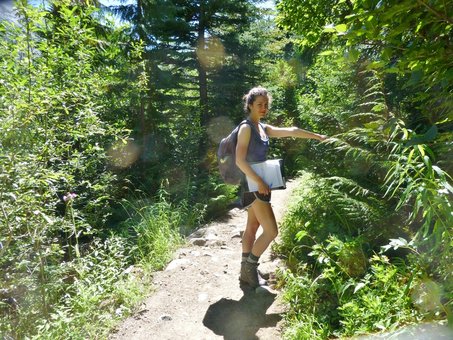About MeadoWatch
 A volunteer on the Glacier Basin Trail "setting up" to survey a plot!
A volunteer on the Glacier Basin Trail "setting up" to survey a plot!
One of the greatest challenges biologist face is forecasting how global climate change will affect plants and animals around us. Climate stations demonstrate that temperatures are rising globally, and that rainfall as well as snowfall events are changing in size and frequency. Ecological studies have shown that plants and animals are responding to this change by shifting the timing of life events; for example, migration, budburst, and reproduction. The results are clear: biological signs of spring are coming earlier. Phenology is the study of the timing of these life events.
Most phenological studies agree that plant species are on average flowering earlier in the spring. However, we often lack detailed information on how organisms of conservation or management interest will respond to climate change. Gathering detailed long-term phenological data on many species at many locations is beyond the scope of most conventional scientific research projects. Additionally, the biological impacts of climate change are still not understood by the general public— in part because most non-scientists lack the opportunity to directly observe and participate in scientific data gathering.
With MeadoWatch we hope to address these critical gaps in our knowledge, establish long-term data collection to facilitate scientific research, and convince National Park visitors of the power of community science. This approach allows MeadoWatch to collect more data than more traditional methods, and creates a community of interested and enthusiastic volunteers.
As a Community Science project, the participation of our volunteers is essential. MeadoWatch is a collaborative project run out of the Hille Ris Lambers Lab and the Brosi Lab at the Department of Biology at the University of Washington working with the National Park Service at Mt. Rainier National Park. We strive to create an engaged community working toward the shared goal of understanding how climate change will impact the places we care about.
Most phenological studies agree that plant species are on average flowering earlier in the spring. However, we often lack detailed information on how organisms of conservation or management interest will respond to climate change. Gathering detailed long-term phenological data on many species at many locations is beyond the scope of most conventional scientific research projects. Additionally, the biological impacts of climate change are still not understood by the general public— in part because most non-scientists lack the opportunity to directly observe and participate in scientific data gathering.
With MeadoWatch we hope to address these critical gaps in our knowledge, establish long-term data collection to facilitate scientific research, and convince National Park visitors of the power of community science. This approach allows MeadoWatch to collect more data than more traditional methods, and creates a community of interested and enthusiastic volunteers.
As a Community Science project, the participation of our volunteers is essential. MeadoWatch is a collaborative project run out of the Hille Ris Lambers Lab and the Brosi Lab at the Department of Biology at the University of Washington working with the National Park Service at Mt. Rainier National Park. We strive to create an engaged community working toward the shared goal of understanding how climate change will impact the places we care about.
Phenology
Phenology is the study of timing of life cycle stages in plants and animals, such as flowering or migration. Essentially, phenology is the study of the seasons. These biological events are frequently tied to weather or climate, and phenological records can help us determine how plants and animals respond to climate change.
With your help, we will record four phenophases (stages of phenology) of ten flowering plants in Mt. Rainier National Park to see how climate affects flowering.
With your help, we will record four phenophases (stages of phenology) of ten flowering plants in Mt. Rainier National Park to see how climate affects flowering.
|
The phenophases we observe include:
Budding – The beginning growth of the flower. The bud will turn into a flower but hasn’t yet opened. Flowering – Usually the showy part of the plant that holds the reproductive parts (stamens and pistils). A plant is flowering when the reproductive parts are visible and available for pollination (reproduction). Ripening Fruit – A fruit develops from the female part of the flower. As the fruit ripens, the seeds within develop. Fruits can take many forms, from a hard or fleshy capsule to a juicy berry. Releasing Seed – After the fruit ripens, the seeds are released to begin the next generation. Fruits can be dispersed by gravity, wind, or animals. |
Articles and Publications
Global change and local solutions: Tapping the unrealized potential of community science for biodiversity research.
Biological Conservation: http://www.sciencedirect.com/science/article/pii/S0006320714004029
Phenological Dataset: https://www.nature.com/articles/s41597-022-01206-8
Biological Conservation: http://www.sciencedirect.com/science/article/pii/S0006320714004029
Phenological Dataset: https://www.nature.com/articles/s41597-022-01206-8
This material is based upon work supported by the National Science Foundation under Grant Number NSF DEB-1054012 and NASA NNX14AC34G (Applied Sciences Division). Any opinions, findings, and conclusions or recommendations expressed in this material are those of the author(s) and do not necessarily reflect the views of these agencies.





